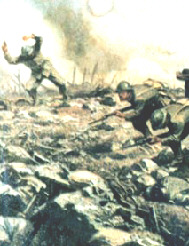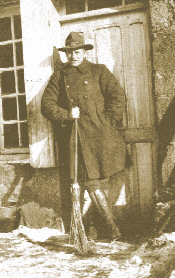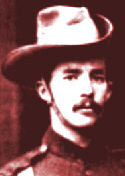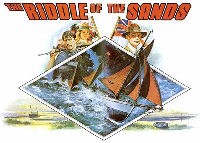
June 2005 |
Access Archives |
|
TRENCH REPORT: As I've mentioned previously, Rich Galli, contributor to our La Grande Guerra website is now deployed with the 163rd Battalion of the Montana National Guard in Iraq. Rich has sent a letter about his experiences to his home town newspaper. Please take a look. (link). Our Correspondents have become especially industrious recently. Lord of the Rings expert Diane Rooney sends the news that the director of the Hobbitt Epic, Peter Jackson, has recently restored combat footage of the Gallipoli campaign using the latest technology. We will inform the Trip-Wire readers when it is available to the public for viewing. . .Efforts are being made to identify the well-preserved body of a World War I soldier found at Passchendaele.(link)
. . .In Lincolnshire, a British village is finally being allowed to honor their fallen in the Great War. (link). . .A 106-year-old World War I veteran threw out the ceremonial first pitch recently at a baseball game in Toronto. Clare Laking climbed out of his wheelchair and made an underhand throw to Blue Jays OF Reed Johnson. Laking was a private with the Canadian Field Artillery, 27th Batter (sic.) Force Brigade, serving as a signaler in Belgium and France.
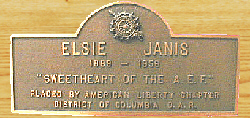 Marker at Burial Vault of |
|||||||||||||||||

| Special Feature Light-Hearted Music of the Great War (Media Player Required) |
 |
WWI Vet Celebrates Memorial Day

A. E. F.
The rifle grooves curling with flakes of rust.
A spider will make a silver string nest in the darkest, warmest corner of it.
The trigger and the range-finder, they too will be rusty.
And so hands will polish the gun, and it will hang on the wall.
Forefingers and thumbs will point absently and casually toward it.
It will be spoken among half-forgotten, wished-to-be-forgotten things.
They will tell the spider: Go on, you're doing good work.
by Carl Sandburg
Source: Smoke and Steel. Sandburg, Carl. New York: Harcourt, Brace and Howe, 1920;
GREAT WAR 2005 EVENT CALENDAR | |
|
Hyde Park, NY June 11, 2005 (link) | |
|
Virginia Military Museum [Full Program Now] Newport News, Virginia September 23-25, 2005 (link) | |
|
Email Response |
|

On March 15, 1918, 15 Million hand grenades exploded at a depot near Courneuve outside Paris. The subsequent fire took two days to extinguish. Thirty persons were killed and many injured.
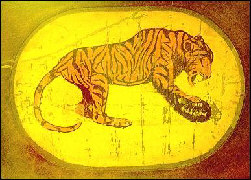
103rd Aero Sq. Insignia
Cavalryman Albert Marshall, 108, who was mentioned in these pages recently has passed away. He was believed to be the last surviving horse solider of the First World War. (link)
Western Front Association Chairman Bruce Simpson announced on May 12th that following negotiations with the Lord Chancellor's Department, the National Archives, and the Ministry of Defence, his organization has been granted custodianship of the Great War Medal Index Cards for the U.K. Well done Mr. Simpson.

Ernst Juenger
Seminar 2005 Photos
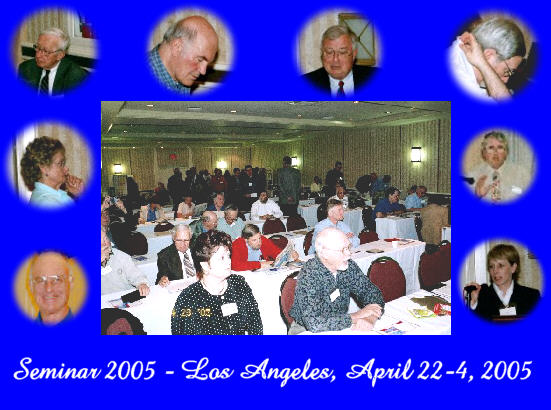
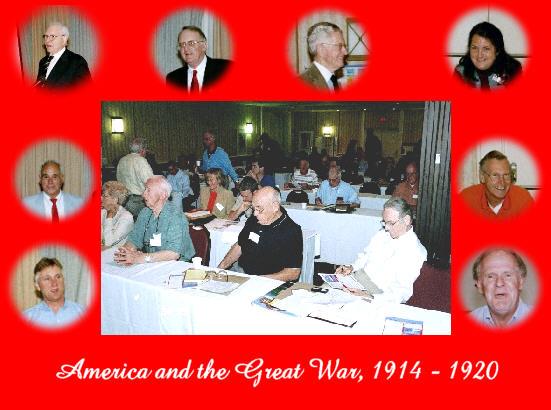
 |
Our Family's Gold Star Pilgrimage
|
Rosa Heidler Lorenz, the gold star mother in this story, is my great grandmother; the source is an excerpt from my own personal story about her life, based on documents carefully saved by her daughters Luella and Josephine. Her son Joseph fought with the 42nd Rainbow Division, was wounded at the River Ourcq, and died at a base hospital in France.
During the 1920's, the national Gold Star Mothers' Association lobbied for a federally sponsored pilgrimage to the cemeteries of Europe for mothers with sons buried overseas. On 2 March 1929, the U.S. Congress passed legislation authorizing funding for Gold Star Mothers and widows "to make a special
pilgrimage to France . . . to visit the graves of husbands and sons killed in the World War. . . The trip will be free, the party being guests of the government."
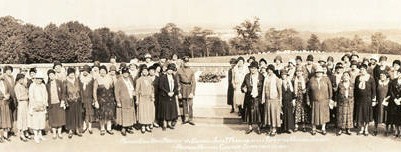
General Pershing with a Group of Gold Star Mothers
Arlington National Cemetery
|
The Government of the United States extends an invitation to Mrs. Rosa Lorenz to
make a pilgrimage to the Cemetery in Europe where the remains of her Son are now
interred. Leaving New York on the Steamship America on May 7, 1930.
|
|
Dayton Gold Star Mothers To Visit Graves of Heroes in France; Others Plan to Go Next Year; Two Weeks to be Allowed in Europe, With Everything Furnished; Touching Scenes are Enacted[Headline]:
Announced yesterday by Congressman Roy G. Fitzgerald, those who are going this year [include] Mrs. Rosa Lorenz, 121 East Fairview. . . The pilgrimage will be made shortly after May 1. . . the total number of widows and gold star mothers going this year from all over the nation will be 5,323. The total number entitled to make the trip during the time allotted, May 1, 1930 to October 31, 1933, is 11,440. . . All expenses will be paid by the government. Each one going will be provided with every possible comfort from their homes to France and return. It is estimated that the cost will average $840 per person. . . All mothers of American service men now buried in European cemeteries and widows of service men who have not remarried are entitled to make the trip. This is being done by the government as a token of recognition to those who gave their all and have not yet visited the graves of their loved ones. . . Memories of more than 11 years ago were recalled. . . One mother said, 'There is my boy in his uniform. He was so proud of it, and I too. That picture was taken just before he left. I never saw him again. Here is a picture of his grave. God bless him, I'll soon see where he is resting. I was afraid that I would pass on and never see his grave'. . . Necessary papers have been sent. . . includes special passports, accommodations, re-entry papers, etc. Each one making the trip will be allowed two weeks in France. Joseph Lorenz, member of the 150th Infantry, machine gun battalion, was wounded in September, 1918. He died on November 22. His grave will be visited by his mother. |
News articles the following May continued the story:
(5 May 1930) Two mothers left Dayton [by train]. . . to visit the graves of their sons who marched away 12 years ago and never came back. Mrs. Rosa Lorenz and Mrs. Julia Lehwald, with gold star badges pinned on their breasts identifying them, said goodbye to relatives on the platform and were whisked away on the long pilgrimage. By the irony of fate, both the mothers are of German extraction. Their sons, killed in battle with the Germans in the fierce fighting of 1918, were buried in different cemeteries. |
Rosa was also given an IDENTITY CARD, written in both English and French, Headquarters in Europe AMERICAN PILGRIMAGE GOLD STAR MOTHERS AND WIDOWS:
|
The bearer of this card, Mrs. ROSA LORENZ, is in France to visit the grave of her SON who lost his life in the World War. She is a member of the official Pilgrimage organized by the United States Government, called "GOLD STAR MOTHERS PILGRIMAGE". Her address in Paris is HOTEL D'IENA, AVENUE D'IENA. You are requested to give her aid or assistance if needed. In case of accident to the bearer of this card, please telephone to the number indicated above or conduct the bearer to the Commissariat de Police du Grand Palais.
RICHARD T. ELLIS, Colonel United States Army, Officer in charge. |
|
New York City welcomed the 350 Gold Star Mothers from the Midwest who will leave on the liner America to visit the graves of their sons in France. . .Drawn up across City Hall Plaza stood companies of soldiers of the regular army, marines, sailors and National Guardsmen and details of Salvation Army lassies, Red Cross nurses, and many war veterans' and civic organizations.
Seven motor buses swung into the plaza bearing the guests. The mothers marched up the City Hall steps and into the Aldermanic Chamber. . . A color guard stood at attention, Federal, State and city officials bowed their heads in tribute, and the mothers took their places, each holding a small American flag. Acting Mayor McKee then extended the official welcome of the city, "If America was great in the World War, it was great because of your boys. They fought and died heroic deaths, and in dying gave tangible manifestation of the idealism of a great nation. . . as long as a cross guards an American soldier's grave in Flanders or in France, there shall be a reminder of the heroism, unselfishness and high idealism of the American people. You go now to take your sad station beside one of those white crosses. . . [with] the prayers of a grateful nation." |
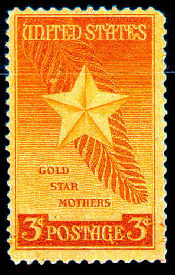 Commemorative Stamp Issued 1948 |
HARBOR CRAFT GIVE SALUTE AND BON VOYAGE [Headlines]:
| The S. S. America, hero ship of the U. S. merchant marine, as it steamed out of the harbor today bearing its load of 350 Gold Star mothers on their way 'over there' to visit their sons' graves, was greeted by whistles and sirens. At left, we see a city fireboat spraying a water barrage in token of the heroic women."
|
| America started her second A.E.F. [American Expeditionary Force] to France today, on the 13th anniversary of the day on which she sent her first soldiers to the trenches over there. . . Thirteen years ago today the camouflaged steamship Orunda slipped out of New York bearing the first Americans to France, a base hospital unit that had been recruited in Cincinnati, Ohio. Today more than a fourth of this first group of 6,000 mothers, who will be traveling to France throughout the summer, came from Ohio." While enroute, there was a formal ceremony to honor the 'Sea Dead'. Rosa and other mothers posed for photographs for the newspapers back home. One reporter commented:
Part II: The Visit will be presented in next month's Trip-Wire. Kathy Compagno is the sister-in-law of Great War Society President Sal Compagno. |

Behind the German Lines
Erskine Childers only novel The Riddle of the Sands was published in 1903 and has never gone out of print. It's considered one of the prototypical espionage stories. The novel was published in the United States in 1915 and was re-issued here in 1940, prior to America's entry in World War II. As a military theoretician, Childers also wrote on the folly of relying on cavalry as an effective fighting force against machine guns.
Andrew Melomet, Proprietor of Andy's Nickelodeon will answer your Great War film or video inquiry. Just click HERE. |
| The following are thanked for their contributions to this issue of the Trip Wire: Tom Jones, Phyllis Pettyjohn, Frank Womble, Tony Langley, Rich Galli, Andy Melomet, Cindy Timmons Carlson, Larry Butler, Dave Patterson, Len Shurtleff, Donna Cunningham, David Beer, Diane Rooney and I hope the Washington Post will forgive me for lifting Lloyd Brown's photo off of their website. Until next month, your editor, Mike Hanlon. |
Membership Information  Click on Icon |
SUBSCRIBE TO THE TRIP-WIRE (Or Send it to a friend.) (Or send us a comment on the TRIP-WIRE) CLICK HERE TO CONTACT US VIA EMAIL |
For further information on the events of 1914-1918
visit the Directory Page of |

